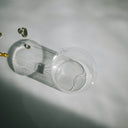Many people dream of having thick, luscious hair that exudes health and vitality. Thick hair is often associated with youthfulness and beauty, and understandably, thinning hair can be a source of concern and diminished self-confidence. Whether you've noticed your hair losing volume over time, becoming finer in texture, or simply wish for a fuller mane, you've likely wondered: can thin hair become thick again?
If you're seeking answers and hoping to restore thickness to your thinning hair, you're not alone. Millions grapple with this concern, and thankfully, there's a wealth of information and strategies available. However, navigating through countless online articles and product claims can be overwhelming. This comprehensive article aims to directly address the question, "Can thin hair become thick again?", providing you with a clear, evidence-based understanding. We'll delve into the science, explore the various causes of thinning hair, discuss proven methods to promote thickness, and set realistic expectations on your journey to fuller, healthier hair.
In this article, we will explore:
- The direct answer to the question: "Can thin hair become thick again?"
- Understanding the common causes of thin hair and hair thinning.
- Factors that influence whether hair thickness can be restored.
- Proven strategies and treatments to promote hair thickness and volume.
- Lifestyle changes that can support thicker, healthier hair growth.
- Realistic expectations and timelines for seeing results.
- When to seek professional help for thinning hair.
Let's embark on this journey to understand the possibilities of achieving thicker hair and empower you with actionable steps!
Table of content
Can Thin Hair Become Thick Again?
In many cases, yes, thin hair can become thicker again. However, the extent to which you can regain thickness and the approach required depends heavily on the underlying cause of your hair thinning and the health of your hair follicles.
While some causes of hair thinning, like genetic predisposition (androgenetic alopecia), might make it challenging to fully restore hair to its original thickness, significant improvement in hair volume, density, and overall thickness is often achievable with the right strategies and consistent effort. The key is to identify the root cause of your thinning hair and implement targeted solutions that address those specific factors.
In essence, while a complete transformation to dramatically thicker hair might not always be possible, significant and noticeable improvement in hair thickness is often within reach with the right knowledge and consistent action.
Understanding the Causes of Thin Hair: Why is My Hair Thinning?
Before exploring how to thicken thin hair, it's crucial to understand *why* hair becomes thin. Hair thinning is not a singular condition but rather a symptom with various potential underlying causes. Identifying the root cause is essential for effective intervention.
Common Causes of Thin Hair:
- Genetics (Androgenetic Alopecia - Pattern Baldness): This is the most prevalent cause of hair thinning, affecting both men and women. Genetically predisposed individuals experience a gradual shrinking of hair follicles over time, leading to thinner hair and eventually hair loss in a characteristic pattern (receding hairline and crown thinning in men, widening part and overall thinning in women).
- Aging: Hair naturally thins with age as hair follicles produce fewer and finer hairs. The hair growth cycle also slows down, leading to reduced hair density and volume.
-
Lifestyle Factors:
- Poor Diet and Nutritional Deficiencies: Inadequate intake of essential nutrients, particularly protein, iron, zinc, biotin, and certain vitamins (like vitamin D and B vitamins), can negatively impact hair health and lead to thinning.
- Chronic Stress: Prolonged physical or emotional stress can trigger telogen effluvium, a temporary form of hair shedding that can result in noticeable hair thinning.
- Harsh Hair Care Practices: Frequent heat styling, chemical treatments (dyeing, perming, relaxing), and tight hairstyles can damage the hair shaft, leading to breakage and the appearance of thinner hair.
- Smoking: Smoking impairs blood circulation to hair follicles and introduces toxins that can damage hair follicles, contributing to thinning and hair loss.
-
Medical Conditions and Medications:
- Thyroid Disorders: Both hypothyroidism (underactive thyroid) and hyperthyroidism (overactive thyroid) can disrupt hair growth and cause hair thinning or loss.
- Autoimmune Diseases: Conditions like alopecia areata, lupus, and certain other autoimmune disorders can attack hair follicles and lead to hair loss and thinning.
- Scalp Infections: Fungal infections (ringworm) or bacterial infections of the scalp can inflame hair follicles and cause hair loss.
- Hormonal Imbalances: Conditions like polycystic ovary syndrome (PCOS) in women and hormonal shifts during menopause or postpartum can contribute to hair thinning.
- Certain Medications: Some medications, including chemotherapy drugs, blood thinners, certain antidepressants, and some blood pressure medications, can have hair thinning as a side effect.
Understanding which of these factors might be contributing to *your* thin hair is the first step toward finding effective solutions for thickening it.
Factors Influencing Hair Thickness Recovery: What Determines Success?
The extent to which thin hair can regain thickness is not uniform for everyone. Several factors play a crucial role in determining the potential for thickness recovery.
Key Determinants of Hair Thickness Restoration:
- Underlying Cause of Thinning: The cause of your thin hair is the most critical factor. Thinning due to lifestyle factors or temporary conditions like telogen effluvium is often more reversible than genetically driven thinning (androgenetic alopecia). Medical conditions need to be addressed medically first to improve hair health.
- Health of Hair Follicles: The health and viability of your hair follicles are paramount. If hair follicles are still active but miniaturized or weakened, there's a greater chance of stimulating them to produce thicker hair. However, if follicles are completely dormant or severely damaged (often in advanced stages of genetic baldness), restoration becomes significantly more challenging.
- Consistency and Commitment to Treatment: Restoring hair thickness is rarely a quick fix. It often requires consistent and long-term effort with chosen strategies and treatments. Patience and adherence to a regimen are crucial for seeing results.
- Timeliness of Intervention: Addressing hair thinning early, when follicles are still relatively healthy, generally yields better results than waiting until thinning is advanced and follicles are significantly compromised. Early action maximizes the chances of successful thickening.
- Overall Health and Lifestyle: Your general health, diet, stress levels, and hair care practices all interact to influence hair health. Optimizing these factors creates a supportive environment for hair growth and thickness recovery.
- Individual Response to Treatments: People respond differently to various hair thickening treatments. What works exceptionally well for one person might be less effective for another due to individual biological variations. Trial and error may be necessary to find the most effective approach for you.
Considering these factors can help you develop realistic expectations and tailor your approach to thickening your hair based on your specific circumstances.
Proven Strategies and Treatments to Make Thin Hair Thicker
Fortunately, there are numerous strategies and treatments available to help make thin hair thicker. The best approach often involves a combination of methods, tailored to your individual needs and the underlying cause of your thinning hair.
Effective Strategies for Thicker Hair:
-
Lifestyle Adjustments for Hair Health:
- Nutritious Diet: Prioritize a balanced diet rich in protein, iron, zinc, biotin, vitamins (especially D and B vitamins), and omega-3 fatty acids. Consider incorporating foods known to support hair health like eggs, nuts, seeds, leafy greens, fatty fish, and berries.
- Stress Management: Implement stress-reducing techniques such as regular exercise, yoga, meditation, deep breathing exercises, or engaging in hobbies you enjoy. Adequate sleep is also crucial for stress management and overall health.
- Gentle Hair Care: Switch to gentle shampoos and conditioners formulated for fine or thinning hair. Minimize heat styling (blow dryers, straighteners, curling irons) and chemical treatments. Use wide-toothed combs and brushes, and avoid tight hairstyles that pull on the scalp.
- Quit Smoking: If you smoke, quitting is essential for overall health and hair health. Smoking significantly impairs circulation and damages hair follicles.
-
Over-the-Counter (OTC) Hair Thickening Products:
- Volumizing Shampoos and Conditioners: These products often contain ingredients that coat the hair shaft, temporarily making it appear thicker. Look for formulas that are lightweight and won't weigh down fine hair.
- Thickening Serums and Sprays: Leave-in serums and sprays can provide instant volume and fullness. Some contain ingredients like polymers, proteins, or biotin to temporarily boost hair thickness.
- Topical Minoxidil (Rogaine): Minoxidil is an FDA-approved OTC topical medication that can stimulate hair growth and increase hair thickness, particularly in androgenetic alopecia. It requires consistent, long-term use to maintain results.
-
Professional Treatments for Hair Thickness (Consult a Doctor or Trichologist):
- Prescription Medications (e.g., Finasteride, Spironolactone): For androgenetic alopecia, doctors may prescribe medications like finasteride (for men) or spironolactone (for women) to block DHT production or androgen effects on hair follicles. These are powerful treatments but require medical supervision and have potential side effects.
- Low-Level Laser Therapy (LLLT): LLLT devices (laser combs, caps) are FDA-cleared for promoting hair growth. They are believed to stimulate hair follicles and improve circulation. Effectiveness varies among individuals.
- Platelet-Rich Plasma (PRP) Therapy: PRP involves injecting concentrated platelets from your own blood into the scalp to stimulate hair follicle growth. It's a more invasive procedure but can be effective for certain types of hair loss.
- Hair Transplantation: For advanced hair loss or significant balding, hair transplantation is a surgical option to restore hair thickness by transplanting hair follicles from donor areas of the scalp to thinning areas.
-
Natural Remedies and Supplements (Discuss with Doctor):
- Rosemary Oil: Rosemary oil has shown promise in studies for stimulating hair growth and potentially improving thickness, particularly in androgenetic alopecia. Diluted rosemary oil can be massaged into the scalp.
- Scalp Massage: Regular scalp massage can improve blood circulation to hair follicles, potentially promoting thicker hair growth.
- Biotin Supplements: While biotin deficiency is rare in developed countries, biotin supplements are often taken for hair health. Discuss with your doctor if biotin supplementation is appropriate for you, as excessive biotin intake can interfere with certain lab tests.
- Other Supplements (e.g., Saw Palmetto, Pumpkin Seed Oil): Some natural supplements are promoted for hair loss and thickness, but scientific evidence is often limited. Discuss any supplement use with your doctor, especially if you have underlying health conditions or are taking medications.
-
Haircuts and Styling Techniques for Thicker Appearance:
- Strategic Haircuts: Certain haircuts can create the illusion of thicker hair. Blunt cuts, layers (done correctly), and shorter styles can often make fine hair look fuller. Consult with a stylist experienced in working with thin hair.
- Volumizing Styling Products: Mousses, root-lifting sprays, and texturizing sprays can add volume and lift to thin hair, making it appear thicker and fuller.
- Hair Fibers and Concealers: For immediate but temporary thickness, hair fibers or colored scalp concealers can be used to fill in thinning areas and create a fuller look.
A multi-faceted approach, combining lifestyle changes, targeted treatments, and appropriate hair care, offers the best chance of achieving thicker, healthier-looking hair.
Managing Expectations and Setting Realistic Goals
While significant improvement in hair thickness is often possible, it's important to have realistic expectations and understand that results vary.
Key Points to Consider for Realistic Expectations:
- Hair Thickness is a Gradual Process: Hair growth is slow, and noticeable changes in thickness take time. Be patient and consistent with your chosen strategies; results are usually not overnight. Expect to see initial improvements over several months, with continued progress over a longer period.
- Full Restoration May Not Always Be Possible: For certain types of hair loss, particularly advanced androgenetic alopecia, achieving a complete restoration to pre-thinning thickness might not be realistic. However, significant improvement in volume and coverage is still often attainable.
- Focus on Improvement, Not Perfection: Aim for *improvement* in hair thickness and overall hair health, rather than chasing an unrealistic ideal of dramatically thicker hair. Even modest gains in volume can make a noticeable difference in appearance and confidence.
- Maintenance is Key: Once you achieve improved hair thickness, ongoing maintenance is crucial to sustain results. Continue with your chosen strategies and lifestyle habits to prevent hair thinning from recurring or progressing.
- Individual Results Vary: Remember that everyone's hair is unique, and responses to treatments vary. What works exceptionally well for one person may be less effective for another. Be prepared to adjust your approach as needed and celebrate even small victories.
By setting realistic expectations and focusing on consistent, evidence-based strategies, you can embark on a journey to improve your hair thickness with a positive and informed mindset.
When to Seek Professional Help for Thinning Hair
While many strategies can be implemented at home, it's essential to know when to seek professional medical advice for thinning hair.
Consult a Doctor or Dermatologist if You Experience:
- Sudden or Rapid Hair Thinning: A sudden and significant increase in hair shedding or thinning should be evaluated by a doctor to rule out underlying medical conditions.
- Patchy Hair Loss: Bald patches or uneven hair loss patterns may indicate alopecia areata or other medical issues requiring diagnosis and treatment.
- Hair Loss with Scalp Symptoms: Scalp itching, pain, redness, scaling, or blisters should be evaluated by a doctor to rule out scalp infections or inflammatory conditions.
- Significant Hair Thinning at a Young Age: Unusual or premature hair thinning, especially in younger individuals, warrants medical investigation.
- Hair Loss Accompanied by Other Symptoms: If hair thinning is accompanied by fatigue, weight changes, skin changes, or other systemic symptoms, consult a doctor to rule out underlying medical conditions.
- Uncertainty and Concern: If you are simply concerned or anxious about your hair thinning, even if it seems mild, consulting a doctor can provide diagnosis, reassurance, and personalized recommendations.
A healthcare professional can properly diagnose the cause of your thinning hair, recommend appropriate treatments based on your specific condition, and monitor your progress. Don't hesitate to seek expert advice when needed – your hair health is worth it!
As your leading source for hair health information over the past 4 years, we never compromise on accuracy. When it comes to your health, you deserve information you can truly rely on - and earning your trust is our top priority.
Here's how Scandinavian Biolabs ensures every piece of content meets the highest standards of accuracy and integrity:
- Credentialed Experts: Our reviewers are actively practicing doctors and medical researchers
- Stringent Reviews: Content undergoes rigorous editing by subject specialists and review by a practicing doctor.
- Evidence-Based: We rely on well-established research from trusted scientific sources like peer-reviewed journals and health authorities.
- Full Transparency: Our editorial standards, writer credentials, reviewer credentials, correction process, and funding are all publicly documented.
- Independent Voice: While we do promote products, we operate in a vacuum to business operations. Our main goal is just an unwavering commitment to providing medically-sound guidance.
You can count on Scandinavian Biolabs to consistently deliver the trustworthy health information you deserve. Read our Editorial Standards.
Conclusion: Can Thin Hair Become Thick Again? – A Hopeful Perspective
Let's recap and solidify our understanding of the journey to thicker hair.
The Reassuring Answer: Yes, in many cases, thin hair *can* become thicker again. While the extent of thickness recovery depends on various factors, significant improvement is often achievable with the right strategies, consistent effort, and a focus on addressing the underlying causes of your thinning hair.
Key Takeaways:
- Thickness Recovery is Possible: Don't lose hope! Thicker hair is often attainable, even if you're starting with thin or thinning hair.
- Identify the Cause: Determine the root cause of your thin hair to guide your approach. Genetics, lifestyle, and medical conditions all play a role.
- Multi-faceted Approach is Best: Combine lifestyle changes, targeted treatments (OTC and professional), and proper hair care for optimal results.
- Consistency and Patience are Key: Hair thickening takes time and consistent effort. Be patient and stick with your regimen.
- Realistic Expectations: Aim for improvement, not necessarily perfection. Even modest gains in thickness can make a difference.
- Seek Professional Help When Needed: Don't hesitate to consult a doctor or dermatologist for diagnosis and personalized treatment recommendations, especially for sudden or concerning hair thinning.
In conclusion, the answer to "Can thin hair become thick again?" is a resounding "Yes, often!" By understanding the causes, implementing proven strategies, and maintaining realistic expectations, you can embark on a hopeful journey to restore thickness, volume, and vitality to your hair. Take action today and nurture your hair back to its fullest potential!
Tired of Thinning Hair? Try a Clinically Tested Serum.
Looking for a natural way to regrow hair and achieve a thicker, fuller head of hair? Ditch the stinging nettle for hair loss – Bio-Pilixin Serum is a drug-free hair activation serum that delivers clinically tested results.
Here's why Bio-Pilixin is superior:
- Clinically Tested Results: 93% of users saw a reduction in hair loss, and 73% experienced increased hair density.
- Safe and Natural: Unlike harsh chemicals, Bio-Pilixin uses plant growth factors derived from stem cell technology to nourish hair follicles and stimulate growth.
- Fast-Acting: See visible results in as little as 45 days (most typically see results within 150 days).
Stop wasting time on unproven remedies. Bio-Pilixin is the safe, natural serum you've been searching for.
Read more:






